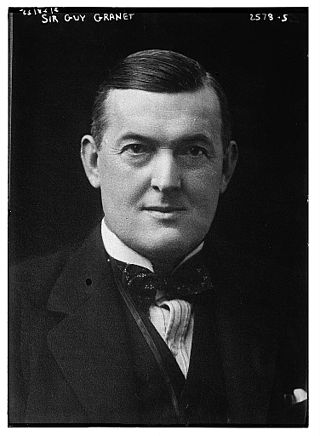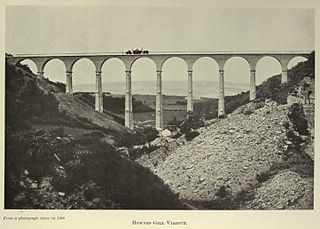Related Research Articles
Chief mechanical engineer and locomotive superintendent are titles applied by British, Australian, and New Zealand railway companies to the person ultimately responsible to the board of the company for the building and maintaining of the locomotives and rolling stock. In Britain, the post of locomotive superintendent was introduced in the late 1830s, and chief mechanical engineer in 1886.

A passenger is a person who travels in a vehicle, but does not bear any responsibility for the tasks required for that vehicle to arrive at its destination or otherwise operate the vehicle, and is not a steward. The vehicles may be bicycles, buses, passenger trains, airliners, ships, ferryboats, and other methods of transportation.
The Stockport and Woodley Junction Railway was incorporated on 15 May 1860 to build a 2 miles 61 chains (4.4 km) railway from Stockport Portwood to a junction with the Manchester, Sheffield and Lincolnshire Railway's (MS&LR) authorised Newton and Compstall line at Woodley.

Sir William Guy Granet, GBE trained as a barrister but became a noted railway administrator, first as general manager of the Midland Railway then as a director-general in the War Office.
A Coercion Act was an Act of Parliament that gave a legal basis for increased state powers to suppress popular discontent and disorder. The label was applied, especially in Ireland, to acts passed from the 18th to the early 20th century by the Irish, British, and Northern Irish parliaments.

Lieutenant Colonel William Yolland CB, FRS FRSA was an English military surveyor, astronomer and engineer, and was Britain's Chief Inspector of Railways from 1877 until his death. He was a redoubtable campaigner for railway safety, often in the face of strong opposition, at a time when railway investment was being directed towards the expansion of the networks rather than the prevention of accidents. He was a member of the three-man committee of inquiry into the Tay Bridge disaster.
The Stephenson Locomotive Society (SLS) was founded in the UK in Autumn 1909 for the study of rail transport and locomotives. More recently, on 1 January 2017, the SLS became a private company limited by guarantee, registered in England and Wales 10471004.

The Railway Clearing House (RCH) was an organisation set up to manage the allocation of revenue collected by pre-grouping railway companies for the conveyance of passengers and goods over the lines of other companies. It went on to become the major regulatory body overseeing the day-to-day running of railways in Great Britain and setting common standards for railway companies, which ensured their safety and interoperability. The RCH also produced fare structures governing many aspects of rail transport at a national level and set limits on price increases for passenger travel.

Park Bridge Railway Station was a railway station on the Oldham, Ashton-under-Lyne and Guide Bridge Junction Railway (OA&GB) that served the village of Park Bridge, in the Medlock Valley near Ashton-under-Lyne's border with Oldham. It was sometimes known as Parkbridge, and one photograph of the station shows the station name board with the name as one word and immediately adjacent the signal box with it shown as two. The station opened on 26 August 1861 when the line opened.
For other stations named Ashton, see Ashton railway station (disambiguation)
The Kington Tramway was an early narrow gauge horse-drawn tramway that linked limestone quarries at Burlinjobb near New Radnor in Radnorshire, Wales, to Eardisley in Herefordshire, England.

The Adams axle is a form of radial axle for rail locomotives that enable them to negotiate curves more easily. It was invented by William Bridges Adams and patented in 1865. The invention uses axle boxes that slide on an arc in shaped horn blocks, so allowing the axle to slide out to either side. This is similar to the movement of a Bissell truck, but with the notional centre point of the curve being where the pivot of the truck would be. This design, using slide bearings, is more expensive than one employing a shaft, but takes up less space.

Sir Henry Oakley was a British railway administrator. He started life as a clerk in the House of Commons Library, and joined the Great Northern Railway (GNR) in the same capacity in 1850. He was chief clerk in the Company Secretary's office until taking over as Secretary in 1858. He became General Manager of the company in 1870.
The Over and Wharton branch line was a railway line serving the town of Winsford in Cheshire. It was owned and operated by the London and North Western Railway Company (LNWR) from 1882 and then the London Midland and Scottish Railway (LMS) until the railways were nationalised under the Transport Act 1947, which took effect on 1 January 1948. Thereafter the branch was operated by British Railways London Midland Region until the line's closure in March 1991.
Railways Act is a stock short title used in India, Malaysia and the United Kingdom for legislation relating to railways.

Robert Hurrell Froude (1771–1859) was Archdeacon of Totnes in Devon, from 1820 to 1859. From 1799 to his death he was rector of Denbury and of Dartington in Devon.

The Hownsgill Viaduct is a former railway bridge located west of Consett in County Durham, England. It is currently used as a footpath and cycleway.
Golborne South railway station was one of two stations serving the town of Golborne, to the south of Wigan.

Preston Brook railway station was a station on the Grand Junction Railway serving the villages of Preston Brook and Preston on the Hill in what was then Cheshire, England. It opened on 4 July 1837 when the line opened.
Basford railway station was a station on the Grand Junction Railway serving the villages of Basford, Hough and Weston in what was then Cheshire, England.
References
- ↑ Alderman, p.20
- ↑ Bonavia, p.32
- ↑ Simmons, Jack, 'Regulation Acts' in Simmons, Jack and Biddle, Gordon (eds), The Oxford companion to British Railway history: from 1603 to the 1990s, Oxford, New York: OUP, 1997, ISBN 0-19-211697-5, page 418
- ↑ Bonavia, p.33
- ↑ Alderman, p.20
- ↑ Alderman, p.42
- ↑ Alderman, p.22
- ↑ Alderman, p.159, pp.279-280
- ↑ Harris, Michael, 'Oakley, Henry (1823-1914)' in Simmons, Jack and Biddle, Gordon (eds), The Oxford companion to British Railway history: from 1603 to the 1990s, Oxford, New York: OUP, 1997, ISBN 0-19-211697-5, page 356
- ↑ Alderman, p.186-191
- ↑ Alderman, p.191, p.321
- ↑ Alderman, p.321
- ↑ Alderman, p.220
- ↑ Bonavia, p.33
- ↑ Harris, p.414
- ↑ Alderman, pp.253-254